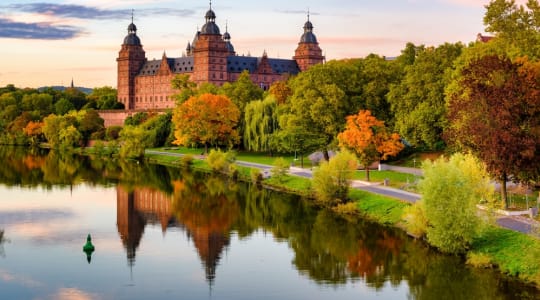Aschaffenburg Castle, also known as Johannisburg Castle, is a Renaissance palace located in the town of Aschaffenburg in Bavaria, Germany. It was built between 1605 and 1614 by the Archbishop of Mainz Johann Schweikhard von Kronberg.
The castle is a prime example of German Renaissance architecture and is considered to be one of the most important buildings of its kind in the country. It features a square floor plan with four corner towers and a central courtyard. The exterior is adorned with decorative sculptures and carvings, including the coat of arms of the Archbishop of Mainz.
The castle was badly damaged during World War II, but was later restored to its former glory. Today, it houses the Bavarian State Archaeological Collection, which contains artifacts from the Stone Age to the Middle Ages. Visitors can also tour the castle's many rooms, including the Knight's Hall, the Red Room, and the Green Room, which are decorated with ornate frescoes, tapestries, and furniture.
In addition to the castle itself, the surrounding gardens are also worth a visit. The Renaissance garden was originally designed to be a pleasure garden for the Archbishop, and features elaborate fountains, sculptures, and an orangery. The English garden, which was added in the 18th century, is a more naturalistic landscape with winding paths, ponds, and an impressive collection of trees.
Aschaffenburg Castle is a popular tourist attraction in Bavaria and is open to visitors year-round. Guided tours are available in English and German, and visitors can also explore the castle on their own. The castle also hosts concerts, exhibitions, and other cultural events throughout the year.
Explore Near Aschaffenburg castle
Discover 5 attractions, 5 cities, and 2 airports within 75km. Perfect for planning day trips, finding connecting flights, or discovering new destinations to explore during your visit.
Nearby Attractions & Places to Visit
5 destinations within 28.3km - 36.0km from your location





Nearby Cities Worth Exploring
5 destinations within 756m - 37.0km from your location
Airports Near Aschaffenburg castle
2 destinations within 41.9km - 71.9km from your location
Cross-Border Adventures Near Aschaffenburg castle
Discover cross-border adventures near Aschaffenburg castle. Explore neighboring countries with similar attractions and extend your travel experience across borders.








And 1 more neighboring countries
